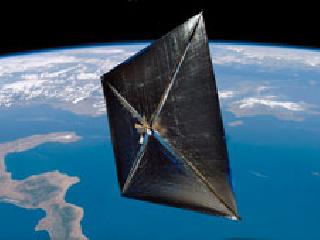
Artist concept of a solar sail in space. A NASA photo
WASHINGTON (BNS): A NASA-designed nanosatellite, about the size of a loaf of bread, has successfully ejected from its mothership – a free-flying microsatellite – and is getting ready to be deployed in the low-Earth orbit.
The NanoSail-D satellite ejected in space from the Fast, Affordable, Science and Technology Satellite (FASTSAT) at 0631 GMT on Monday, “demonstrating the capability to deploy a small cubesat payload from an autonomous microsatellite in space,” NASA said.
The tiny satellite, similar to a solar sail, was launched along with the FASTSAT on November 19, 2010 from Alaska.
“The successful ejection of NanoSail-D demonstrates the operational capability of FASTSAT as a cost-effective independent means of placing cubesat payloads into orbit safely,” Mark Boudreaux, FASTSAT project manager at the Marshall Space Flight Center in Huntsville, Alaska, said.
The NanoSail-D will now prepare to be deployed in the low-Earth orbit in the next three days.
While being deployed in the Earth orbit, the satellite will use its large sail made of thin polymer material, much thinner than a single human hair, to significantly reduce the time to de-orbit its mother satellite without using propellants as done by most traditional satellites.
After ejection, a timer within NanoSail-D will begin a three day countdown as the satellite orbits the Earth. Once the timer reaches zero, four booms will quickly deploy and the NanoSail-D sail will start to unfold to a 100 square foot polymer sail. Within five seconds the sail fully unfurls.
If the deployment is successful, NanoSail-D will stay in low-Earth orbit between 70 and 120 days, depending on atmospheric conditions, NASA said.
NASA aims to use similar technology on large spacecrafts to de-orbit space debris created by decommissioned satellites without using valuable mission propellants if the NanoSail D technology demonstration programme successfully achieves its mission objectives.
 Previous Article
Previous Article Next Article
Next Article













The Indian Air Force, in its flight trials evaluation report submitted before the Defence Ministry l..
view articleAn insight into the Medium Multi-Role Combat Aircraft competition...
view articleSky enthusiasts can now spot the International Space Station (ISS) commanded by Indian-American astr..
view article